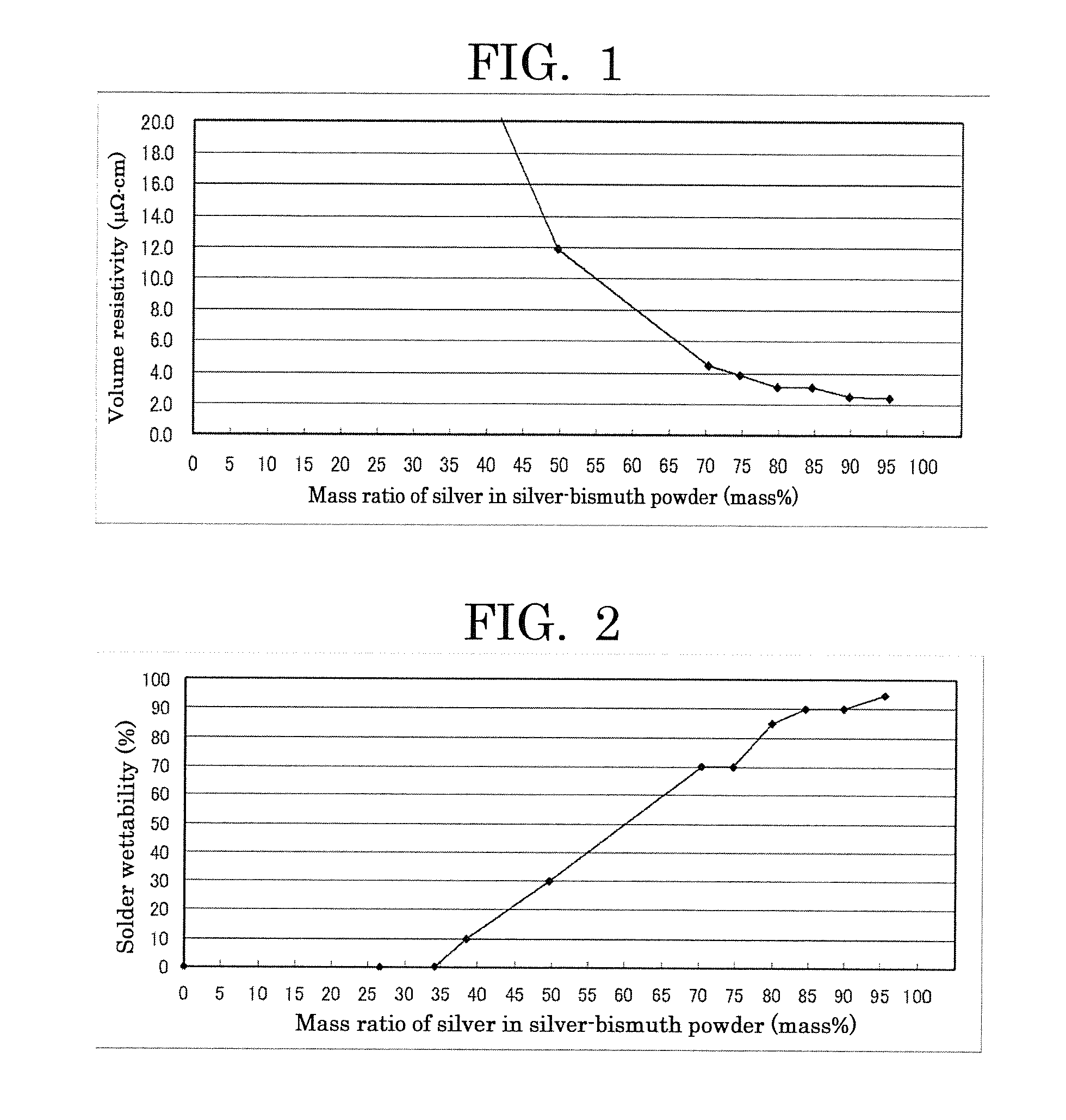Silver-Bismuth Powder,Conductive Paste and Conductive Film
a technology of silver-bismuth powder and conductive paste, which is applied in the direction of metal/alloy conductors, conductors, and transportation and packaging, etc., can solve the problems of reduced conductivity, increased cost, and inability to use conductive paste in oxidizing atmosphere, and achieve excellent conductivity, excellent solder wettability, and low volume resistivity
- Summary
- Abstract
- Description
- Claims
- Application Information
AI Technical Summary
Benefits of technology
Problems solved by technology
Method used
Image
Examples
example 1
Production of Powder by Water Atomization Process
[0062]A molten metal obtained by heating and melting silver and bismuth of the blending ratio depicted in Table 1 was dropped from a bottom part of a tundish, to which high-pressure water was sprayed to quench and solidify the molten metal. The resulting powder was filtered, and washed with water. Thereafter, the powder was dried (for 7 hours at 120° C.), crushed, and then subjected to an air classification process, to thereby produce each powder of Nos. 1 to 12.
[0063]For example, 3.8 kg of silver and 0.2 kg of bismuth were blended for the powder of No. 2.
[0064]Next, each of the produced powders were evaluated in various properties thereof in the following manners. The results are presented in Table 1.
[0065]As for a particle size distribution of each of the produced powders a cumulative 10% point of particle diameter (D10), a cumulative 25% point of particle diameter (D25), a cumulative 50% point of particle diameter (D50), a cumulati...
example 2
Production of Conductive Paste
[0071]A vehicle prepared by dissolving 4 g of an acrylic resin (BR-105, manufactured by Mitsubishi Rayon Co., Ltd.) in 12 g of butyl carbitol acetate (reagent, manufactured by Wako Pure Chemical Industries, Ltd.), 82 g of each of the produced powders, and 2 g of a glass frit (ASF-1100, manufactured by ASAHI GLASS CO., LTD., softening point: 440° C.) were mixed by means of a kneading deaerator, and the resulting mixture was passed through a triple roll mill 5 times to thereby homogeneously disperse the mixture. In the manner as described, conductive pastes of Nos. 1 to 12 were produced.
[0072]Each of the obtained conductive pastes was applied onto an aluminum substrate into a pattern having a line width of 500 μm, and a line length of 37.5 mm by screen printing, followed by drying in the atmospheric air for 10 minutes at 150° C. by means of a drier (DK-43, manufactured by Yamato Scientific Co., Ltd.). Thereafter, the resultant was burned in the atmospheri...
PUM
| Property | Measurement | Unit |
|---|---|---|
| laser diffraction particle size distribution | aaaaa | aaaaa |
| laser diffraction particle size distribution | aaaaa | aaaaa |
| softening point | aaaaa | aaaaa |
Abstract
Description
Claims
Application Information
 Login to View More
Login to View More - R&D
- Intellectual Property
- Life Sciences
- Materials
- Tech Scout
- Unparalleled Data Quality
- Higher Quality Content
- 60% Fewer Hallucinations
Browse by: Latest US Patents, China's latest patents, Technical Efficacy Thesaurus, Application Domain, Technology Topic, Popular Technical Reports.
© 2025 PatSnap. All rights reserved.Legal|Privacy policy|Modern Slavery Act Transparency Statement|Sitemap|About US| Contact US: help@patsnap.com


